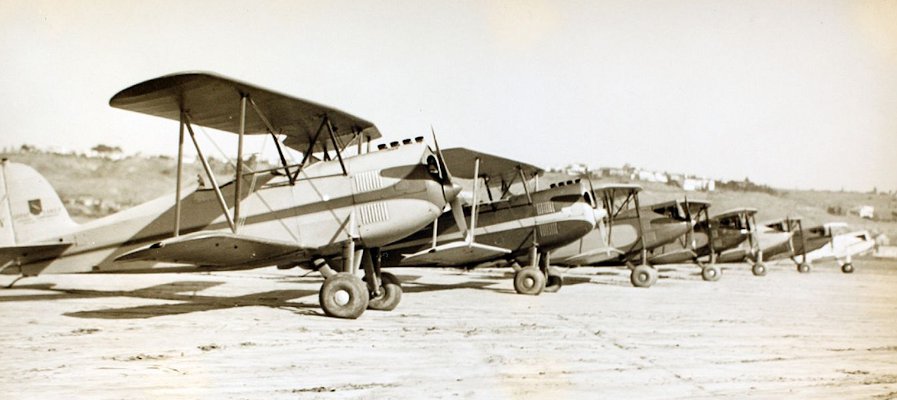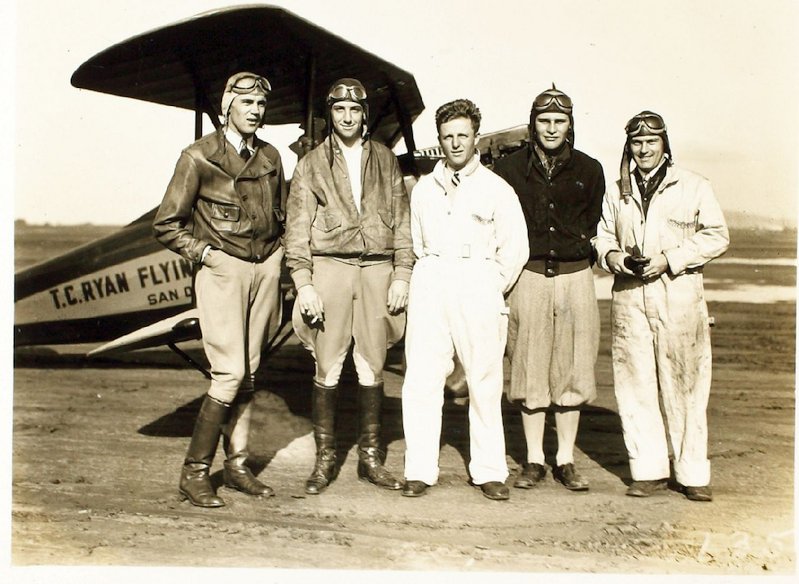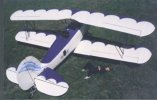Would you like to make this site your homepage? It's fast and easy...
Yes, Please make this my home page!
The Great Great Lakes!
Airshow
Great
Lakes Home Photos1
Photos2
Photos3
Photos4
Get
Plans Specs
WebLinks
Website
Home
GREAT LAKES BIPLANE HOME
Welcome to my Great Lakes 2T
Sport Trainer website. This is not an official Great Lakes
company website. Just my fun website with info and
pictures about the Great Lakes Sport Trainer. The greatest
biplane ever manufactured. (In my humble opinion). Click on the
links above to visit different parts of this website.
Thanks for visiting! God bless you,
Mike Townsley webmaster
HISTORY
of the Great Lakes Sport Trainer


Photos of T.C. Ryan Flying School...they used Great Lakes
for training
This page starts with a
little history of the Great Lakes Trainer came out in the 1920's
and 1930's. Then we will talk about the later history of
the plane. In the 1970-80's the plane came BACK INTO
production.
The original was
designed by Great Lakes Aircraft engineers. The airfoil was a
NACA M-12 designed by Dr. Max Munk. This gave the plane better
inverted flight than its contemporaries. The planes were built
from 1929-about 1932. The first engine the factory installed was
a American Cirrus Mark III built by American Cirrus Engines, Inc
(A.C.E.) which had 80 horse power. This first plane had a small
tail and it was called the 2T-1. The first four 2T-1s had a
straight upper wing. But to help solve some spin problems all
the later planes had a swept top wing. Later models used the the
improved 85 HP Cirrus engine and they were called the 2T-1A. The
later 2T-1A's came out with a big tail and other mods but still
called a 2T-1A. Then the final 1930's version had a big tail and
an inverted 95 HP Cirrus High Drive or "Ensign" engine. It
was designated a 2T-1E.
___________________________________________________________________
Let me share with you some
Great Lakes background sent to me by Harvey Swack, the "Great
Lakes Guru."
"Over the years I have
answered many questions about the Great Lakes Sport Trainer and
still more questions arise to add to the luster of the name and
the mystery surrounding this fine airplane. Also some
people hear strange stories, so this explanation for the
airplane and it;s background needs to be explained and explored
for the benefit of those interested in this plane."
"First, let me explain that it was designed by people who had
been employed by Glen L. Martin, so the engineering skill of
designing biplanes was clearly evident in this design. The
project Engineer was Cliff Leisy who had been with the Martin
organization for several years. Other very qualified
engineers were employed to work with him and the basic design
was done in 90 days. A wooden mock up was first produced
and when approved, the first aircraft was produced. Then
engine selected was the 90 h.p. American Cirrus produced in the
United States. It was identical to the English Cirrus,
except for the engine rotation was opposite of the English
version. The holding company for Great Lakes owned the
Cirrus rights and that is why it was used. Actually the
first few experimental models used English Cirrus engines until
the American company could supply them. The Great Lakes
Company never produced or sold any Great Lakes Sport Trainers
with any other engine installed! Yes, they tried several
engines, all under 100 h.p. but never sold any airplanes with
these engines installed. In fact, they converted them back
to the standard configuration before selling them. "
"Everyone knows the story of
why the top wing was swept back so I won't repeat it here.
(ED: It was done for Center of Gravity reasons) The
critical thing to know is that the Munk M-12 Airfoil was used
and a 3 degree incidence was incorporated. This was done
to satisfy the fact that a 14 and 1/2 degree deck angle had to
be used with this configuration to obtain the 40 mph landing
speed. "
"Every effort was made to
minimize weight as the selected engine produced 90 h.p.
Also every part of the requirements was that this was to be an
airplane designed to a G load factor of positive 9 and a
negative 6. That meant every trick in the book was used to
bring this about including the following: "
Wing spars routed to save 16 lbs.
All nuts and bolts were made to the exact size needed. This
saved 16 lbs.
Outside the wing spars very little wood was used. Wing ribs
were 17 ST .016 aluminum
Everything was designed to weight the least yet still meet the +9
-6 G strength requirement!
The size of the airplane was
made to carry people who were 5'3" to 5'5" tall and weighed 135
to 145 pounds, as that was the average weight of men in 1929!
Martin made all their own nuts
and bolts and Great Lakes continued to do so after they took
over the plant until 1931 or 32. Then the Army and Navy
required all government contractors to use AN nuts and bolts.
"The question is asked, why
they selected the American Cirrus engine? The answer is
they were producing an airplane to replace the Curtis Jenny
which had been grounded and had been used as a trainer using the
90 hp OX-5 engine. There certainly was a market for this
kind of airplane at the time, and once introduced proved to be a
real winner. A supercharged Cirrus engine was tested but
never produced for the market. The inverted Cirrus powered
Great Lakes were called the 2T-1E (E stood for "Ensign").
The upright American Cirrus engine powered Great Lakes was
called the 2T-1A (A abbrevated the name of American Cirrus
Engine company or "ACE".)".
"In examining the six years of
company records, I found no hint that they ever tried to use
more than 90 hp because the airplane was designed to CAA part
7. This corresponds to Part 23 today and the most
interesting thing is that several of these airplanes built in
1929 were analysed and found that they were strong enough to
meet Part 23 when 180 hp was installed!"
"The question of why people want to put a 220 hp Jake
or 220 hp Continental in these airplanes baffles me because they
miss what the airplane is all about. A 90 hp Cirrus powered
Great Lakes held the outside loop record for many years. The
total number was 131 and the record was held by Tex Rankin.
If you ever had or tried to do an outside loop, you would find
that you need plenty of horsepower. I personally fell
out of many trying it in the Stearman I took my aerobatic training
in. I always ended up doing a split S in the 220 hp
Stearman. I never did one until the Ohio State University
put a 330 Lycoming in one of these trainers and converted it to a
crop duster. What I am getting at is that this airplane will
do wonders with no more than 160 hp Lycoming 0-320. They are
plentiful and not in such great demand. Keeping this plane
light with out burdening it with big iron up front will give
you more pleasure for your time, effort and money! "
"However when the first
company first started to build the new Great Lakes in the 1970's
they were required to beef up in several areas to meet new
certification requirements. For example, the
original Sport Trainers had an empty weight of 1016 lbs. and the
new production ones (180hp Lyc) weighed empty at 1250 lbs.
Of course more equipment like inverted systems, more and modern
instruments, wheels, brakes, and constant speed props all add up
to higher empty weights. For comparison look at the weights and
performance figures of the original and new production
airplanes."
"To set the record straight
Charlie Myers was the company test pilot, NOT the designer of
the Great Lakes Sport Trainer! Further, I do not recommend
using more that 200 hp on the Great Lakes Sport Trainer.
Bigger horsepower means more weight and that detracts from the
performance. When you can almost get the same performance
as a newer 180 hp Great Lakes using a 125 hp 0-290 or a 0-320
Lycoming of 140 to 160 hp in a homebuilt that weighs only 1025
lbs, then why bother overpowering this fine airplane with more
horsepower?"
_________________________________________________________________________________
Harvey Swack is the man who
has given a lot of his life to keep the Great Lakes Sport
Trainer alive. He and some friends built a Great Lakes for
a museum in Clevelend Oh. He had plans drawn up and sold
them to homebuilders for many years (still does sell
them!) Harvey has done extensive research on the Great
Lakes and its history. He helped see the Great Lakes into
production in the 1970's and continues today to specialize in
selling Great Lakes Sport Trainers. If you have questions about
the Great Lakes Sport Trainer, email them to me and I will
forward them to Harvey. He will be glad to answer questions.
Great
Lakes Sport Trainer History Part 2
Because of the Great
Depression, many aircraft companies went under. Great
Lakes was one of them. So by the mid 1930's the only Great
Lakes you could buy was a used one. It wasn't until the
1960's that Harvey Swack got a hold of the factory plans and
spearheaded building an airplane for a Cleveland Museum.
Harvey decided to start marketing the plans and homebuilt Great
Lakes Sport Trainers were birthed. To build a
homebuilt GLST is a major undertaking, but many have done
it. Some are powered by Warner engines, Ranger engines,
Continental and Lycoming engines. Check out the photo's
pages for pictures.
In the 1970's a man by the
name of Doug Champlin of Enid, Oklahoma with Harvey's help
decided to put the airplane back into production. It was
reworked to meet government requirements, fitted with new
Lycoming engines and walla! A person could buy a Great
Lakes Sport Trainer new from the factory! The Great Lakes
wasn't a memory any more.
Great Lakes came out with two
models. The 2T-1A-1 (140 hp fixed pitch prop and two
ailerons) and the 2T-1A-2 (180 hp constant speed prop and 4
ailerons). Later the company was sold and
moved several times and production continued for around 6 years
or so. See specs by clicking here.
The original paint job was an
attractive with strips of red black and white or blue
black and white.
I understand the airplane went
out of production in the mid 1980's when the factory at that
time in Clearmont, New Hampshire, wanted to move and was denied
by the local city government.
Chris Hanisko sent me the following picture.
click on pic to see a larger view
He writes: "This photo of all
the Wichita employees was taken spring of 78. Although I was not
working on the biplane at that time I got in on the photo. I'm
the one right behind the forward cockpit. The guy to the right
of me in the photo is Stogie (the one with the cigar in his
mouth). This was how the airframe left Wichita, structurally
complete, control cables loose installed and sitting on it's
gear. The fuselage went a specially built open trailer with the
wings in racks on either side. Then it was towed to Enid, about
a two hour drive. All covering and paint was then done there
prior to final assy." Chris Hanisko
Great Lakes Sport Trainer History Part 3
Waco Classic is now manufacturing factory
certified Great Lakes Sport Trainers! Click here to see all
about this beauty.
The
Debate-- 2 or 4 Ailerons?
You may see a Great Lakes with
2 ailerons (bottom wings only) or one with 4 ailerons (bottom
and top wings). Why the difference? The original
1920's-30's had 2 ailerons only. Then Tex Rankin modified
one to 4 ailerons after seeing and flying the Jungmeister.
Several others followed his example. They were trying to get a
faster roll rate with 4 ailerons. When the new generation
Great Lakes came out in the 1970's they produced 2 models.
One had 4 ailerons (180 hp models I believe) and some had 2
ailerons (150 hp models I believe). Some homebuilders have
built their Lakes with 2 ailerons only and some have built their
Lakes with 4 ailerons. According to Harvey Swack, Nick
D'Appuso did a test between the 4 and 2 aileron versions.
Nick said there was not much advantage in the 4 aileron versions
in roll rate. Harvey says that a 2 aileron version with
good cuffs on the lower N struts will produce good roll rates
equal to the 4 aileron version.
The Great Lakes Today
John Duncan
has acquired the manufacturing rights of the Great Lakes 2T
Sport Trainer and the Warner Radial aircraft engine. He worked
with Waco Classic to bring the Great Lakes back into
production.
You can visit his
website at http://www.greatlakesaircraftcompany.com
Or you can visit the Waco Classic website here: https://www.wacoaircraft.com/great-lakes-by-waco




